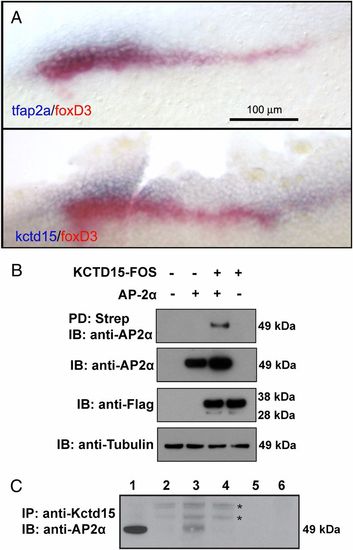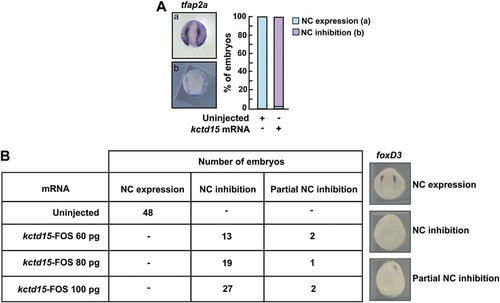- Title
-
Inhibition of neural crest formation by Kctd15 involves regulation of transcription factor AP-2
- Authors
- Zarelli, V.E., and Dawid, I.B.
- Source
- Full text @ Proc. Natl. Acad. Sci. USA
|
Kctd15 and tfap2 expression overlaps in zebrafish embryos, and the protein products interact physically. (A) Expression domains of tfap2a and kctd15 (both blue) are compared with foxD3 (red). Anterior to the left, midline to bottom. (B) KCTD15 and AP-2α interact in mammalian cells. KCTD15 tagged with FOS and TFAP2a were cotransfected into HEK293T cells. Immunoblotting (IB) was carried out with Flag, AP-2α, and tubulin antibodies. (C) Co-IP of endogenous AP-2α and Kctd15 in one-somite-stage embryo extracts. Lanes are as follows: 1: AP-2α marker from co-IP of zAP-2α and Kctd15 expressed in HEK293T cells; 2: beads plus embryo extract, used as control; 3: beads plus embryo extract and anti-Kctd15 antibody; 4: beads plus buffer; 5: empty; 6: input, embryo lysate. Lanes 2 and 3 contain extract from 100 embryos, whereas lane 6 could be loaded with 3 embryos only because of high protein levels; therefore no band is seen. Background bands indicated by asterisks. |
|
Functional interactions between AP-2 and Kctd15. (A) Expression of tfap2a in the neural crest (NC() region was inhibited by kctd15 overexpression. Zebrafish embryos were injected with 80 pg of kctd15 mRNA, collected at bud stage, and hybridized to tfap2a probe. Fifty control and 57 kctd15-injected embryos were scored. In the histogram, embryos with the appearance in A,a correspond to blue, whereas embryos as in A, b correspond to purple. (B) Kctd15 tagged with the Flag-ONE-Strep (FOS) epitope maintains biological activity. Zebrafish embryos were injected with increasing concentrations of kctd15-FOS mRNA. In situ hybridization with the NC marker foxD3 shows inhibition in injected embryos, similar to that seen with untagged Kctd15 (1). |


